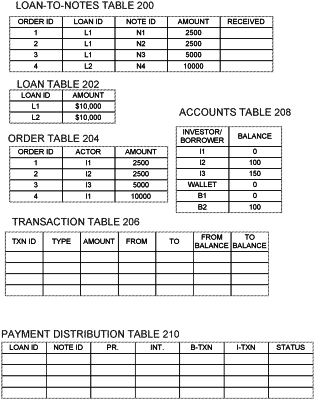| CPC G06Q 40/03 (2023.01) [G06Q 20/36 (2013.01)] | 18 Claims |

|
1. A method for reducing workload of a computer system that performs transactions between entities that have many-to-many relationships by aggregating transactions in the computing system, comprising:
during a one-to-intermediary phase in which a triggering condition has not been satisfied:
receiving, at a database system, a first request for a first one-to-many operation between a first entity and a plurality of first target entities;
wherein the plurality of first target entities are a subset of a set of target entities;
wherein the first request requires:
a first set of one or more updates to one or more values, stored in the database system, associated with the first entity; and
a plurality of first target updates, wherein each first target update of the plurality of first target updates is to one or more values, stored in the database system, associated with a respective first target entity of the plurality of first target entities; and
in a first transaction, the database system performing the first set of one or more updates, to values stored in the database system, and a first corresponding set of one or more updates to one or more values, stored in the database system, associated with an intermediary;
receiving, at the database system, a second request for a second one-to-many operation between a second entity and a plurality of second target entities;
wherein the plurality of second target entities are a subset of the set of target entities;
wherein the second request requires:
a second set of one or more updates to one or more values, stored in the database system, associated with the second entity; and
a plurality of second target updates, wherein each second target update of the plurality of second target updates is to one or more values, stored in the database system, associated with a respective second target entity of the plurality of second target entities; and
in a second transaction, the database system performing the second set of one or more updates, to values stored in the database system, and a second corresponding set of one or more updates to one or more values, stored in the database system, associated with the intermediary;
wherein one or more common target entities are common to both the plurality of first target entities and the plurality of second target entities;
detecting that the triggering condition is satisfied;
during an intermediary-to-many phase after detecting that the triggering condition is satisfied:
performing, by the database system, a single transaction for each target entity in the set of target entities to:
cause the one or more values, stored in the database system, associated with each respective first target entity to reflect the plurality of first target updates;
cause the one or more values, stored in the database system, associated with each respective second target entity to reflect the plurality of second target updates; and
update one or more values, stored in the database system, associated with the intermediary to reflect performance of the plurality of first target updates and performance of the plurality of second target updates;
wherein the single transaction performed, by the database system, for each common target entity performs an update that aggregates the first target update that corresponds to the common target entity with the second target update that corresponds to the common target entity.
|